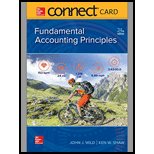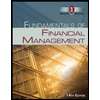
Connect Access Card For Fundamental Accounting Principles
24th Edition
ISBN: 9781260158526
Author: John J Wild
Publisher: McGraw-Hill Education
expand_more
expand_more
format_list_bulleted
Textbook Question
Chapter 10, Problem 9E
Exercise 10-9
Straight-line
P1
Tory Enterprises pays $238,400 for equipment that will last five years and have a $43,600 salvage value. By using the equipment in its operations for five years, the company expects to earn $88,500 annually, after deducting all expenses except depreciation.
Prepare a table showing income before depreciation, depreciation expense, and net (pretax) income for each year and for the total five-year period, assuming straight-line depreciation.
Expert Solution & Answer
Want to see the full answer?
Check out a sample textbook solution
Students have asked these similar questions
correct answer please
Give this question financial accounting
1.3
1.2.5
za
When using a computerised accounting system, the paper work will
be reduced in the organisation.
Calculate the omitting figures: Enter only the answer next to the
question number (1.3.1-1.3.5) in the NOTE. Round off to TWO decimals.
VAT report of Comfy shoes as at 30 April 2021
OUTPUT TAX
INPUT TAX
NETT TAX
Tax
Gross
Tax(15%)
Gross
(15%)
Standard
75 614,04
1.3.1
Capital
1.3.2
9 893,36
94 924,94
Tax
(15%)
1.3.3
Gross
484 782,70
75 849,08 -9 893,36
-75 849,08
Bad
Debts
TOTAL
1.3.4
4 400,00 1 922,27
14 737,42 -1 348,36
1.3.5
(5 x 2)
(10
Chapter 10 Solutions
Connect Access Card For Fundamental Accounting Principles
Ch. 10 - Prob. 1DQCh. 10 - Prob. 2DQCh. 10 - Prob. 3DQCh. 10 - Prob. 4DQCh. 10 - Prob. 5DQCh. 10 - Prob. 6DQCh. 10 - Prob. 7DQCh. 10 - Prob. 8DQCh. 10 - Prob. 9DQCh. 10 - Prob. 10DQ
Ch. 10 - Prob. 11DQCh. 10 - Prob. 12DQCh. 10 - Prob. 13DQCh. 10 - Prob. 14DQCh. 10 - Prob. 15DQCh. 10 - Prob. 16DQCh. 10 - Prob. 17DQCh. 10 - Prob. 18DQCh. 10 - Prob. 19DQCh. 10 - Prob. 20DQCh. 10 - Cost of plant assets C1 Kegler Bowling installs...Ch. 10 - Assigning costs to plant assets C1 Q Listed below...Ch. 10 - Straight-line depreciation P1 On January 1= the...Ch. 10 - QS 10-' Units-of-production depreciation
On...Ch. 10 - QS10-5 Double-declining-balance method P1
A...Ch. 10 - Prob. 6QSCh. 10 - Prob. 7QSCh. 10 - Prob. 8QSCh. 10 - Revenue and capital expenditures C3 1. Classify...Ch. 10 - Prob. 10QSCh. 10 - Natural resources and depletion P3 Perez Company...Ch. 10 - Prob. 12QSCh. 10 - Prob. 13QSCh. 10 - Prob. 14QSCh. 10 - Prob. 15QSCh. 10 - Prob. 16QSCh. 10 - Exercise 10-1 Cost of plant assets C1 Q Rizio Co....Ch. 10 - Prob. 2ECh. 10 - Prob. 3ECh. 10 - Exercise 104 Straight-line depreciation P1 Ramirez...Ch. 10 - Exercise 10-5 Units-of-production depreciation P1...Ch. 10 - Exercise 10-6
Double-declining-balance...Ch. 10 - Exercise 10-7 Straight-line depreciation P1
New...Ch. 10 - Exercise 10-8 Double-declining-balance...Ch. 10 - Exercise 10-9 Straight-line depreciation and...Ch. 10 - Exercise 10-10
Double-declining-balance...Ch. 10 - Exercise 10-11 Straight-line, partial-year...Ch. 10 - Exercise 10-12 Dauble-declining-balance....Ch. 10 - Exercise 10-13
Revising depreciation
C2
Apex...Ch. 10 - Exercise 10-14 Ordinary repairs, extraordinary...Ch. 10 - Exercise 10.15 Extraordinary repairs; plant asset...Ch. 10 - Exercise 10-16 Disposal of assets P2 Diaz Company...Ch. 10 - Exercise 10-17 Partial-year depreciation: disposal...Ch. 10 - Exercise 10-18 Depletion of natural resources P3...Ch. 10 - Exercise 10-19 Amortization of intangible assets...Ch. 10 - Exercise 10-20 Goodwill P4 Robinson Company...Ch. 10 - Exercise 10-21 Preparing a balance sheet P1 P3...Ch. 10 - Exercise 10-22 Evaluating efficient use of assets...Ch. 10 - Exercise 10-23A Exchanging assets P5
Gilly...Ch. 10 - Prob. 24ECh. 10 - Problem 10-1A Plant asset costs; depreciation...Ch. 10 - Problem 1O-2A Depreciation methods P1 A machine...Ch. 10 - Problem 10-3A Asset cost allocation; straight-line...Ch. 10 - Problem 10-4A
Computing and revising depreciation;...Ch. 10 - Problem 10-5A Computing and revising depreciation;...Ch. 10 - Problem 1O-6A
Disposal of plant assets
C1 P1...Ch. 10 - Problem 1O7A
Natural resources
P3
On July 23 of...Ch. 10 - Prob. 8APSACh. 10 - Problem 10-1B Plant asset costs; depreciation...Ch. 10 - Problem 10-28 Depreciation methods P1 On January...Ch. 10 - Problem 10-3B Asset cost allocation; straight-line...Ch. 10 - Prob. 4BPSBCh. 10 - Problem 10-5B Computing and revising...Ch. 10 - Problem 1O-6B
Disposal of plant assets
C1 P1 P2
On...Ch. 10 - Prob. 7BPSBCh. 10 - Prob. 8BPSBCh. 10 - Prob. 10SPCh. 10 - Prob. 1AACh. 10 - Prob. 2AACh. 10 - Prob. 3AACh. 10 - Prob. 1BTNCh. 10 - Prob. 2BTNCh. 10 - Prob. 3BTNCh. 10 - Prob. 4BTNCh. 10 - Prob. 5BTNCh. 10 - Prob. 6BTN
Knowledge Booster
Learn more about
Need a deep-dive on the concept behind this application? Look no further. Learn more about this topic, accounting and related others by exploring similar questions and additional content below.Similar questions
- Nonearrow_forwardWhat was her capital gains yield? General accountingarrow_forwardL.L. Bean operates two factories that produce its popular Bean boots (also known as "duck boots") in its home state of Maine. Since L.L. Bean prides itself on manufacturing its boots in Maine and not outsourcing, backorders for its boots can be high. In 2014, L.L. Bean sold about 450,000 pairs of the boots. At one point during 2014, it had a backorder level of about 100,000 pairs of boots. L.L. Bean can manufacture about 2,200 pairs of its duck boots each day with its factories running 24/7. In 2015, L.L. Bean expects to sell more than 500,000 pairs of its duck boots. As of late November 2015, the backorder quantity for Bean Boots was estimated to be about 50,000 pairs. Question:arrow_forward
arrow_back_ios
SEE MORE QUESTIONS
arrow_forward_ios
Recommended textbooks for you

 Intermediate Accounting: Reporting And AnalysisAccountingISBN:9781337788281Author:James M. Wahlen, Jefferson P. Jones, Donald PagachPublisher:Cengage Learning
Intermediate Accounting: Reporting And AnalysisAccountingISBN:9781337788281Author:James M. Wahlen, Jefferson P. Jones, Donald PagachPublisher:Cengage Learning College Accounting, Chapters 1-27 (New in Account...AccountingISBN:9781305666160Author:James A. Heintz, Robert W. ParryPublisher:Cengage Learning
College Accounting, Chapters 1-27 (New in Account...AccountingISBN:9781305666160Author:James A. Heintz, Robert W. ParryPublisher:Cengage Learning Fundamentals of Financial Management (MindTap Cou...FinanceISBN:9781285867977Author:Eugene F. Brigham, Joel F. HoustonPublisher:Cengage Learning
Fundamentals of Financial Management (MindTap Cou...FinanceISBN:9781285867977Author:Eugene F. Brigham, Joel F. HoustonPublisher:Cengage Learning Fundamentals of Financial Management, Concise Edi...FinanceISBN:9781285065137Author:Eugene F. Brigham, Joel F. HoustonPublisher:Cengage Learning
Fundamentals of Financial Management, Concise Edi...FinanceISBN:9781285065137Author:Eugene F. Brigham, Joel F. HoustonPublisher:Cengage Learning Accounting (Text Only)AccountingISBN:9781285743615Author:Carl Warren, James M. Reeve, Jonathan DuchacPublisher:Cengage Learning
Accounting (Text Only)AccountingISBN:9781285743615Author:Carl Warren, James M. Reeve, Jonathan DuchacPublisher:Cengage Learning


Intermediate Accounting: Reporting And Analysis
Accounting
ISBN:9781337788281
Author:James M. Wahlen, Jefferson P. Jones, Donald Pagach
Publisher:Cengage Learning

College Accounting, Chapters 1-27 (New in Account...
Accounting
ISBN:9781305666160
Author:James A. Heintz, Robert W. Parry
Publisher:Cengage Learning

Fundamentals of Financial Management (MindTap Cou...
Finance
ISBN:9781285867977
Author:Eugene F. Brigham, Joel F. Houston
Publisher:Cengage Learning

Fundamentals of Financial Management, Concise Edi...
Finance
ISBN:9781285065137
Author:Eugene F. Brigham, Joel F. Houston
Publisher:Cengage Learning

Accounting (Text Only)
Accounting
ISBN:9781285743615
Author:Carl Warren, James M. Reeve, Jonathan Duchac
Publisher:Cengage Learning
Depreciation -MACRS; Author: Ronald Moy, Ph.D., CFA, CFP;https://www.youtube.com/watch?v=jsf7NCnkAmk;License: Standard Youtube License